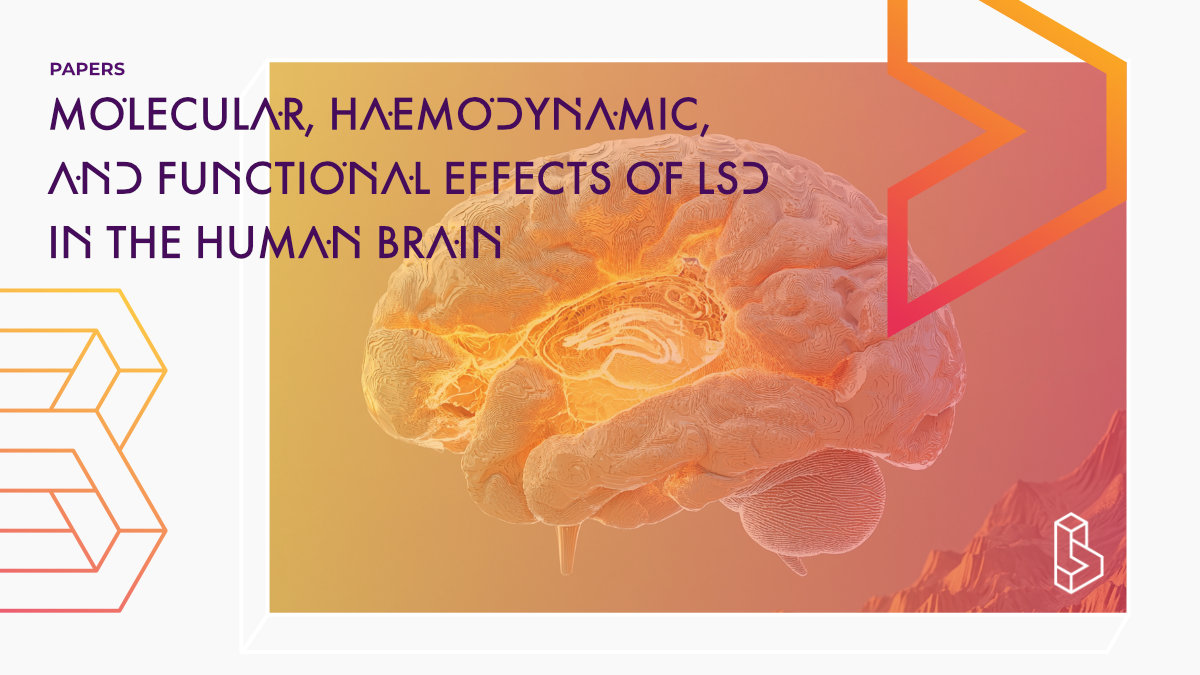This pre-print simultaneous PET-MRI study (first of its kind) demonstrates that LSD increases global cerebral blood flow and internal carotid artery flow without affecting artery diameter (opposite to psilocybin’s effects), while decreasing global connectivity (particularly in visual networks) and increasing network entropy and spatial complexity, with researchers also observing an anticlockwise hysteresis loop (dynamic lag between an input and an output) between plasma levels and subjective effects that challenges existing hypotheses about psychedelic mechanisms of action.
Abstract of Molecular, haemodynamic, and functional effects of LSD in the human brain
“In this study, we provide the first study to integrate molecular and functional neuroimaging during psychedelic drug effects in humans. Using simultaneous PET-MRI technology, we describe multiple brain actions of lysergic acid diethylamide (LSD) in healthy volunteers. We quantify the occupancy of LSD at cerebral serotonin 2A receptors and show that LSD increases global cerebral blood flow and internal carotid artery flow without affecting the diameter of the internal carotid artery, opposite effects to those observed following psilocybin. Functional connectivity analyses showed widespread decreases in global connectivity, particularly in visual networks, alongside increases in network-wise sample entropy and spatial complexity. We observed an anticlockwise hysteresis loop between plasma drug levels and subjective effects, suggesting atypical pharmacodynamic mechanisms. By establishing the dose-occupancy relation of LSD in humans, our findings provide critical insights for the clinical development of psychedelic compounds and demonstrate unique neurophysiological effects that distinguish LSD from related psychedelics. Our findings challenge the leading hypotheses of psychedelic brain-action, until now thought to be instrumental for therapeutic efficacy.“
Authors: Drummond E-Wen McCulloch, Kristian Larsen, Annette Johansen, Kristian H. Reveles Jensen, Charlotte Havelund Nykjær, Friederike Holze, Nora Falck, Victor Neufeld, Emilia Steenstrup, Peter Skov-Andersen, Anders Spanggård, Maria Geisler, Paw Patrick Randrup, Peter Steen Jensen, Vladimir Shulganov, Sys Stybe Johansen, Marie Katrine Klose Nielsen, Thomas Lund Andersen, Dea Siggaard Stenbæk, Claus Svarer, Patrick MacDonald Fisher & Gitte Moos Knudsen
Summary of Molecular, haemodynamic, and functional effects of LSD in the human brain
Drummond and colleagues investigate the pharmacodynamic effects of lysergic acid diethylamide (LSD) on the human brain, integrating molecular and functional neuroimaging for the first time in a single study. The significance of this work is underlined by recent Phase I and IIa trials that have shown LSD, up to 200 micrograms (µg), to be safe and effective in reducing anxiety symptoms, prompting multiple ongoing Phase III trials for anxiety and depression.
LSD exerts its effects primarily through the serotonin 2A receptor (5-HT2AR), which is highly expressed in the human neocortex. Earlier research has shown that 5-HT2AR agonism is both necessary and sufficient for inducing psychedelic experiences. For instance, ketanserin, a 5-HT2AR antagonist, reliably blocks LSD’s subjective effects. Unlike psilocybin, LSD shows a delay between peak plasma concentration and peak subjective experience, a phenomenon possibly explained by its unusually slow receptor binding and dissociation due to structural peculiarities.
While previous studies using functional MRI have reported changes in connectivity and entropy under psychedelics, few have linked these with receptor occupancy or vascular effects. The authors aim to fill these gaps using simultaneous PET-MRI technology to map LSD’s impact on 5-HT2AR occupancy, cerebral blood flow (CBF), and global brain function.
Methods
Study Design
Find this paper
Molecular, haemodynamic, and functional effects of LSD in the human brain
https://doi.org/10.1101/2025.06.17.25329677
Open Access | Google Scholar | Backup | 🕊
Cite this paper (APA)
McCulloch, D. E. W., Larsen, K., Johansen, A., Reveles Jensen, K. H., Nykjaer, C. H., Holze, F., ... & Knudsen, G. M. (2025). Molecular, haemodynamic and functional effects of LSD in the human brain. medRxiv, 2025-06.
Study details
Compounds studied
LSD
Topics studied
Neuroscience
Healthy Subjects
Study characteristics
Original
Single-Blind
Bio/Neuro
Participants
11
Humans
Compound Details
The psychedelics given at which dose and how many times
LSD 25 - 200μg | 1x
Linked Clinical Trial
LSD Occupancy of the Serotonin 2A Receptor in the Human Brain (dOccLS)This early-phase, interventional trial (n=40) investigates LSD occupancy at the serotonin 2A receptor (5-HT2AR) in the human brain. Healthy participants aged 18-75 will receive a single dose of LSD ranging from 25 to 200 micrograms equivalent freebase.

